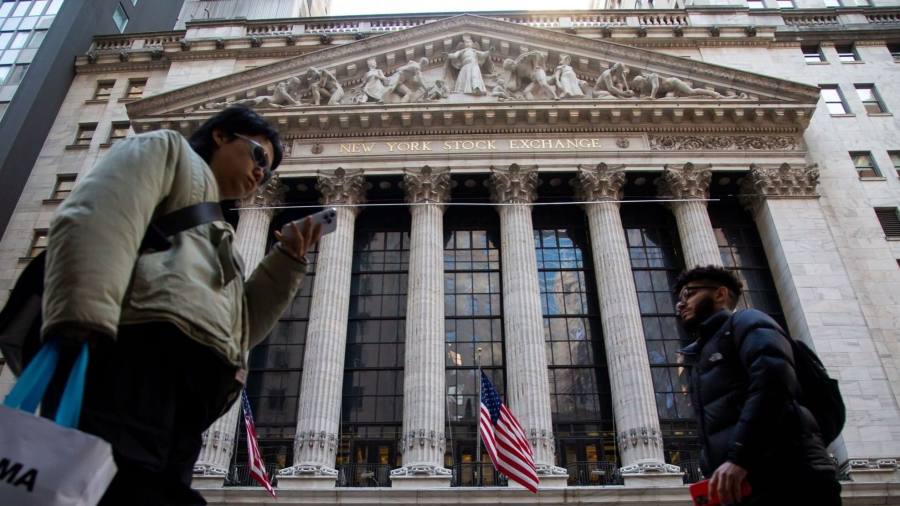Chaos in the US banking sector has caused historic swings in bond markets this month and prompted the Federal Reserve to ditch plans for more rapid interest rate rises.
But judging by moves in Wall Street’s flagship stock index, the crisis appears to have been a non-event.
The S&P 500 is flat so far this month, and volatility indicators suggest investors are not expecting wild swings in the next few weeks.
“From a trading desk perspective, some moments have been more hectic than others,” said Alex Kosoglyadov, managing director of equity derivatives at Nomura. “There’s definitely a high level of uncertainty . . . [but] I thought it was impressive how well the overall market held up.”
Traders and investors broadly agree on the factors that have helped prop up the S&P through the turmoil that began with the collapse of Silicon Valley Bank. Cautious positioning in the run-up to the crisis limited losses while calm at the index level has masked a significant shake-up in certain sectors — particularly banks. However, there is less agreement over how long the relative calm will continue.
Part of the reason for the quiet, according to Goldman Sachs Asset Management’s Brett Nelson, is that many of the people who were liable to dump stocks in a crisis had already done so. The S&P 500 entered a bear market more than nine months ago so, by the time SVB collapsed on March 10, many investors had already scaled back their exposure, reducing the likelihood of a further exodus from the market.
“This bank crisis began with the market already in a double digit drawdown . . . People are already at a base level of equity exposure, and you need to own something,” he said.
Nelson said the same factor had helped keep the Vix — the index of options prices often referred to as Wall Street’s “fear gauge” — relatively low after a brief bounce. It touched a high of almost 31 shortly after SVB’s collapse, but has since fallen back to less than 22 — only slightly above its long-term average.
“Protective [options] buying and Vix spiking — that’s the behaviour you see when people have a lot of exposure and need to hedge,” he added.
The light positioning in stocks marks a stark contrast with the US Treasury market, where many investors had made similar bets on rising interest rates. When SVB’s collapse upended expectations of how high rates would go, the reversal in bond prices was exacerbated by investors rushing to unwind their earlier positions.
That volatility provided a further boost to stocks, as lower yields increase the relative appeal of long-term corporate earnings.
Federal Reserve chair Jay Powell said on Wednesday that the central bank still expected one further rate rise before an extended pause, but futures markets suggest most investors expect cuts to begin soon.
“That would be positive for equity markets,” said Nancy Curtin, chief investment officer at Alvarium Tiedemann. “Market expectations around tightening have moved significantly lower. I’m not sure the Fed is quite there . . . but there has been a definite change in tone.”
Lower rates provide a particular boost to companies in high-growth areas such as tech, which have a disproportionate impact on the S&P 500 — the top 10 companies account for around a quarter of the index’s value.
Apple and Microsoft, the two largest companies on the index, have climbed 9 per cent and 12 per cent respectively this month. Google parent Alphabet is up 17 per cent.
Their outsized gains are offsetting problems at smaller businesses.
“The market is getting very narrow,” said Michael Wilson, chief US equity strategist at Morgan Stanley. “The biggest weights in the index are high-quality big cap tech stocks, those are what people are flocking to. So the broader index holds up while under the surface the breadth is breaking down.”
If every company in the S&P 500 had an equal weighting, the index would be down 6 per cent this month. The Russell 2000 index of small cap stocks has dropped almost 9 per cent.
Kosoglyadov at Nomura said shares in smaller companies were being hit by investors’ concerns that problems in the banking sector would lead to a credit crunch, making it harder to borrow and weighing on economic growth.
“The megacap companies . . . are a little bit less reliant on credit financing because they generate so much cash on their own [so] there’s been a bit of a flight to safety,” he said.
A continuation of that flight to safety could continue to prop up the broader index, although Morgan Stanley’s Wilson was sceptical it would last.
Powell acknowledged after this week’s Fed meeting that the chances of avoiding a recession had grown even more remote in the wake of the banking crisis, and Wilson argued that analysts’ earnings estimates would need to come down as companies feel the effects of an economic downturn.
Wilson said: “These companies that people are flocking to are not immune to the slowdown . . . even though [some] people perceive them as not being economically sensitive, If you have a recession or something that looks like one, they feel it.”
Read the full article here



